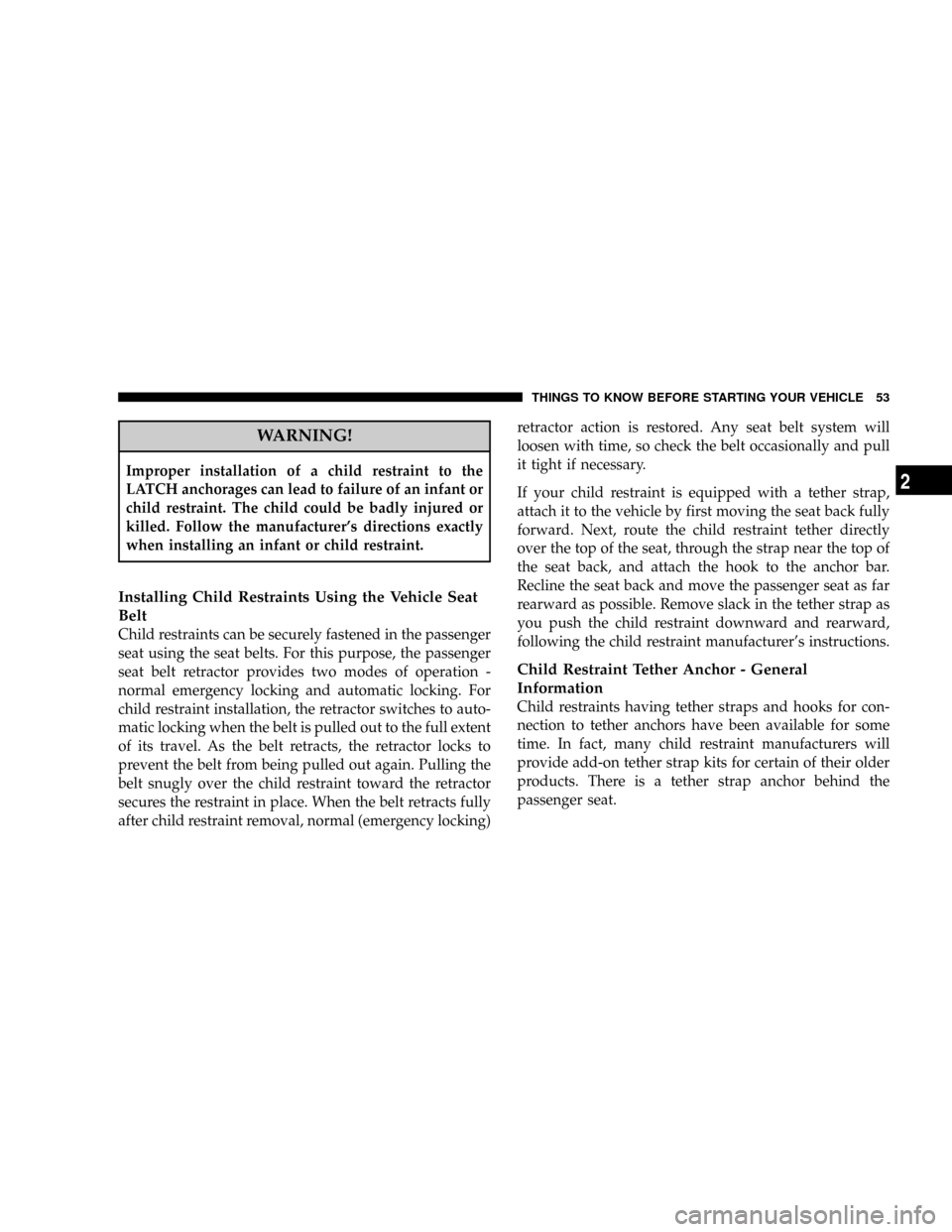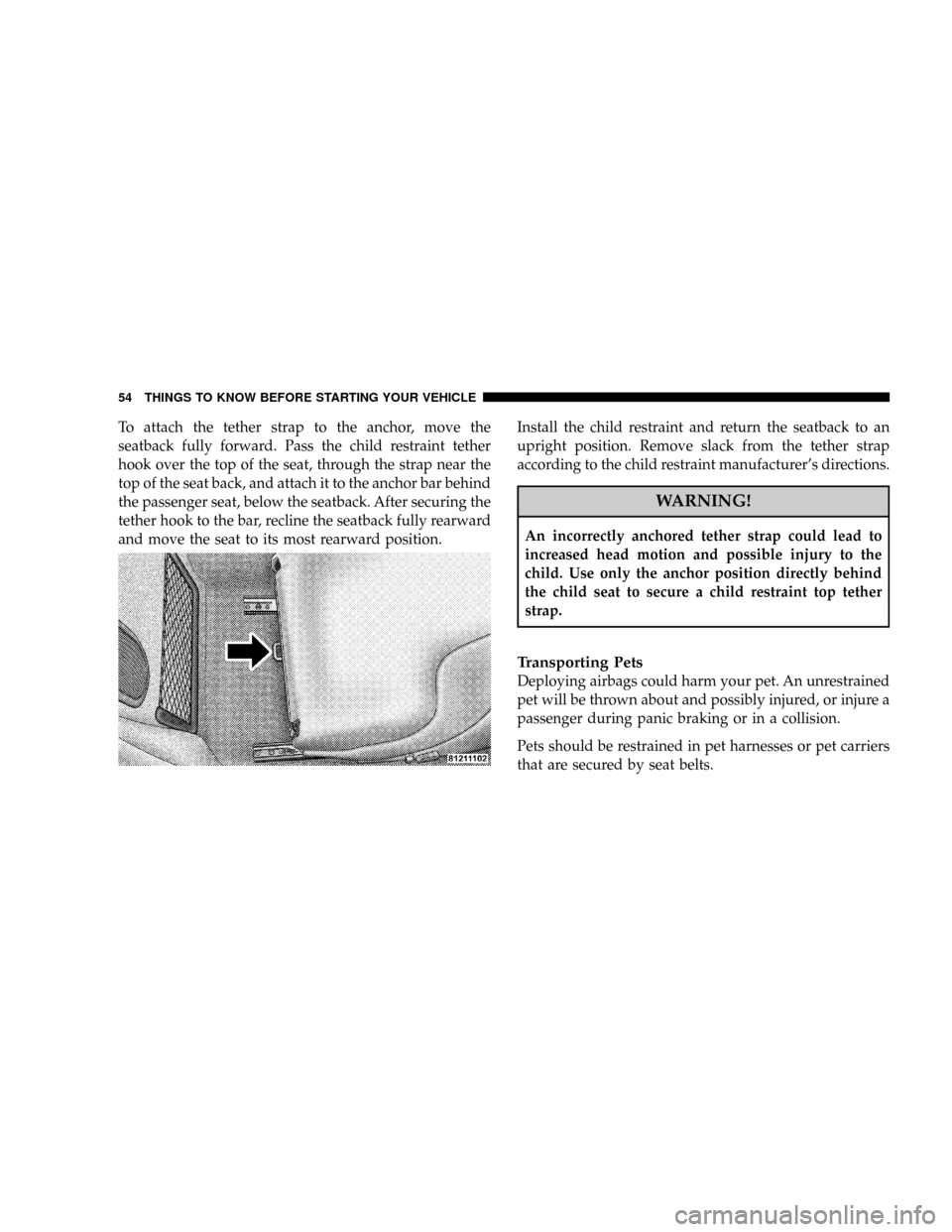Page 50 of 299

Children Too Large For Booster Seats
Children who are large enough to wear the shoulder belt
comfortably, and whose legs are long enough to bend
over the front of the seat when their back is against the
seat back, should use the lap/shoulder belt.
²Make sure that the child is upright in the seat.
²The lap portion should be low on the hips and as snug
as possible.
²Check belt fit periodically. A child's squirming or
slouching can move the belt out of position.
²If the shoulder belt contacts the face or neck, move the
child closer to the center of the vehicle. Never allow a
child to put the shoulder belt under an arm or behind
their back.
LATCH - Child Seat Anchorage System (Lower
Anchors and Tether for Children)
Your vehicle's passenger seat is equipped with the child
restraint anchorage system called LATCH. The LATCH
system provides for the installation of the child restraint
without using the vehicle's belts, instead securing the
child restraint using lower anchorages and upper tether
straps from the child restraint to the vehicle structure.
LATCH-compatible child restraints are now available.
Installing the LATCH-Compatible Child Restraint
System
We urge that you carefully follow the directions of the
manufacturer when installing your child restraint. These
are general instructions, and not all child restraint sys-
tems will be installed exactly as described here. Again,
carefully follow the installation instructions that were
provided with the child restraint system.
50 THINGS TO KNOW BEFORE STARTING YOUR VEHICLE
Page 53 of 299

WARNING!
Improper installation of a child restraint to the
LATCH anchorages can lead to failure of an infant or
child restraint. The child could be badly injured or
killed. Follow the manufacturer's directions exactly
when installing an infant or child restraint.
Installing Child Restraints Using the Vehicle Seat
Belt
Child restraints can be securely fastened in the passenger
seat using the seat belts. For this purpose, the passenger
seat belt retractor provides two modes of operation -
normal emergency locking and automatic locking. For
child restraint installation, the retractor switches to auto-
matic locking when the belt is pulled out to the full extent
of its travel. As the belt retracts, the retractor locks to
prevent the belt from being pulled out again. Pulling the
belt snugly over the child restraint toward the retractor
secures the restraint in place. When the belt retracts fully
after child restraint removal, normal (emergency locking)retractor action is restored. Any seat belt system will
loosen with time, so check the belt occasionally and pull
it tight if necessary.
If your child restraint is equipped with a tether strap,
attach it to the vehicle by first moving the seat back fully
forward. Next, route the child restraint tether directly
over the top of the seat, through the strap near the top of
the seat back, and attach the hook to the anchor bar.
Recline the seat back and move the passenger seat as far
rearward as possible. Remove slack in the tether strap as
you push the child restraint downward and rearward,
following the child restraint manufacturer's instructions.
Child Restraint Tether Anchor - General
Information
Child restraints having tether straps and hooks for con-
nection to tether anchors have been available for some
time. In fact, many child restraint manufacturers will
provide add-on tether strap kits for certain of their older
products. There is a tether strap anchor behind the
passenger seat.
THINGS TO KNOW BEFORE STARTING YOUR VEHICLE 53
2
Page 54 of 299

To attach the tether strap to the anchor, move the
seatback fully forward. Pass the child restraint tether
hook over the top of the seat, through the strap near the
top of the seat back, and attach it to the anchor bar behind
the passenger seat, below the seatback. After securing the
tether hook to the bar, recline the seatback fully rearward
and move the seat to its most rearward position.Install the child restraint and return the seatback to an
upright position. Remove slack from the tether strap
according to the child restraint manufacturer's directions.
WARNING!
An incorrectly anchored tether strap could lead to
increased head motion and possible injury to the
child. Use only the anchor position directly behind
the child seat to secure a child restraint top tether
strap.
Transporting Pets
Deploying airbags could harm your pet. An unrestrained
pet will be thrown about and possibly injured, or injure a
passenger during panic braking or in a collision.
Pets should be restrained in pet harnesses or pet carriers
that are secured by seat belts.
54 THINGS TO KNOW BEFORE STARTING YOUR VEHICLE
Page 60 of 299

NHeated Seats (If Equipped)...............83
mTo Open And Close The Hood.............84
mInterior Lights.........................85
NFront Map/Reading Lights...............85
NBattery Saver Feature...................85
NInstrument Panel Lighting................86
NNight Security Illumination...............86
mExterior Lights.........................86
NHeadlights And Parking Lights............86
NDaytime Running Lights (Where Applicable) . . .87
NFog Lights (If Equipped).................87
NStanding Lights.......................87
mMultifunction Control Lever...............88
NTurn Signals..........................88
NHeadlight Dimmer Switch................89
NPassing Light.........................90NWindshield Wipers And Washer............90
NMist Function.........................91
mTelescoping Steering Column..............92
mTire Pressure Monitor System (If Equipped)...93
mRear Spoiler...........................96
mBrake Assist System (BAS)................98
mElectronic Stability Program (ESP)...........99
NSynchronizing ESP....................101
mElectronic Speed Control.................102
NTo Vary The Speed Setting...............103
NTo Deactivate........................104
NTo Resume Speed.....................104
NUsing Speed Control On Hills............105
mGarage Door Opener (If Equipped).........105
NProgramming The Universal Transceiver.....106
NGate Operator/Canadian Programming.....108
60 UNDERSTANDING THE FEATURES OF YOUR VEHICLE
Page 61 of 299
NUsing The Universal Transceiver..........109
NErasing Universal Transceiver Buttons.......109
NReprogramming a Single Button...........109NSecurity............................109
mUmbrella Hook.......................110
UNDERSTANDING THE FEATURES OF YOUR VEHICLE 61
3
Page 64 of 299

CAUTION!
To avoid possible damage to the tonneau cover and
convertible top, do not allow the convertible top to
remain in the suspended position. After approxi-
mately 10 minutes in the suspended position, the
hydraulic pressure will be released which will allow
the top and the tonneau cover to lower. The convert-
ible top switch can be pressed to cancel this
operation.
CAUTION!
To avoid damage to either the top or the rear window,
check the tonneau cover area at the rear of the vehicle
interior to be sure that it is clear of debris or other
items. Do not use the tonneau cover area for other
storage purposes.
CAUTION!
To fully insure that no damage occurs, be sure that
the vehicle is at a complete stop before attempting to
lower or raise the top.
NOTE:If the top stops during the raising or lowering
procedure, start the engine and continue operation.
1. Make sure the rear cargo compartment divider is
unfolded and secured in the vertical position.
If the divider is in its stowed position, first unfold the
panels towards the rear of the vehicle. Pull up on the
vertical panel using the center cutout shown, and hook
the pins at the top into the brackets mounted to the cargo
compartment trim on each side near the forward edge of
the decklid opening. The pins must be hooked in these
brackets in order for the top to operate.
64 UNDERSTANDING THE FEATURES OF YOUR VEHICLE
Page 67 of 299
NOTE:Once the top is lowered and the audible signal
is heard, you can continue to push the convertible top
switch down or push it within 2 seconds to raise the
windows.
The windows can also be closed/opened later using the
power window switches.CAUTION!
To prevent mildew, the convertible top must be dry
before lowering it into the storage compartment.
Do not lower a frozen convertible top until thawed
and dry. Doing so may result in damage not covered
by the DaimlerChrysler Limited Warranty.
CAUTION!
Do not place anything on the tonneau cover.
The tonneau cover must never be used as a seating
area.
To Raise The Top:
1. Make sure the rear cargo compartment divider is still
secured in the vertical position.
2. Make sure the decklid is closed.
UNDERSTANDING THE FEATURES OF YOUR VEHICLE 67
3
Page 69 of 299
7. When the top engages to the header, turn the latch
handle counterclockwise just over one quarter turn to the
lock position and push the latch handle up to the stored
position. The top is now secured in the closed position.
NOTE:The convertible top switch indicator will light
up and an audible warning will be heard if you start
driving the vehicle without the top fully locked in the
closed position.
WARNING!
To prevent possible accidents, drive the vehicle only
with the convertible top either completely closed and
locked, or fully lowered into its storage compartment.
8. Once the top has been raised and locked, the cargo
compartment divider can be unhooked and folded for-
ward to increase the cargo compartment capacity. Follow
the steps shown on the label affixed to the decklid trim.
UNDERSTANDING THE FEATURES OF YOUR VEHICLE 69
3